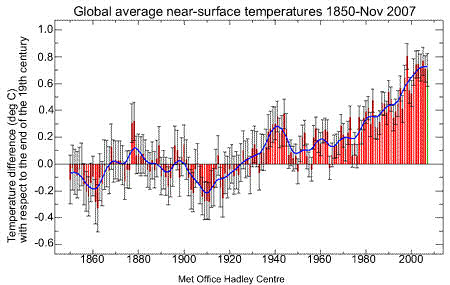A simple explanation of Human induced Climate Change
In this page I have tried to summarise how we are changing the climate, presenting you with some of the key phrases, like "greenhouse gas" and "global warming". There are links at the bottom to useful, on-line sources of further information.

Our atmosphere might seems pretty big, from where we stand, but it is actually a relatively thin blanket around us. We are changing it and therefore changing patterns of weather around the world. The following explains the climate change issue in very simple terms: there is more to it, for example if you start to consider the way the atmosphere is linked to the oceans, and all of the other intricate feedback processes.
- We burn oil, gas and coal for fuel (for transport, heat, electricity generation, etc), this produces carbon dioxide. Some of our other activities, like farming (especially rice paddy fields and cattle), produce other gases like methane. As a result of our activities, these gases have significantly increased in concentration in the atmosphere (for example carbon dioxide has increased from a pre-industrial concentration of 280 ppm [parts per million] to 379 ppm in 2005).
- Carbon dioxide and methane are important gases in the atmosphere's greenhouse effect. The gases trap heat giving a similar effect to adding a blanket round the planet (or a greenhouse around your prize seedlings).
- We are increasing the concentration of the gases that cause the greenhouse effect, this is causing the atmosphere to warm up (global warming).
- Whilst there are natural processes that change the concentrations of the greenhouse gases, for example volcanic eruptions, it is important to note that the changes we have made (the anthropogenic changes) are much bigger than anything that has happened within the last 20+ million years.
- The atmosphere acts as a system to move energy from hot areas to cold areas (e.g. from the equator to the poles). This heat energy is moved in the wind and in the movement of moisture (e.g. forming clouds and rain). Global warming means that there is more energy in the atmosphere. This will change the patterns of these energy movements, which we see as weather. These changing weather patterns are what we mean when we talk about climate change.
- There is a lot of uncertainty about how much the climate will change. It partly depends on how much we (the human race) take this problem seriously and really cut down on (i.e. mitigate) our emissions of carbon dioxide, etc. It also depends on a lot of luck: the atmosphere is an incredibly complex system, which can very quickly move from stable to extreme states. We do have an understanding of the likely changes though. They won't be the same across the world: some places will become hotter, others may get cooler; some areas will get wetter, others will become drier. There is also likely to be more extreme weather.
- The weather affects a lot of other things that are vital for life. Extreme weather, like hurricanes and floods, can be disastrous: destroying lives and homes. Shifting weather patterns can cause areas to change, e.g. from scrub land to desert, which will effect agriculture and damage ecosystems: leading to fears of plague, as species of plants and animals can find it very difficult to adapt (or move) quickly, causing them to die out and be replaced by opportunistic forms of life.
Links to more sources of information
The following websites have further explanations and diagrams, which you may find useful:
- The Frequently Asked Questions document on the IPCC's website. This is really good!
- The Earthguide's simple animation that explains how the greenhouse effect happens.
.jpg)
Return to main About Climate Change page

![link to W3C validation website, which will show that the stylesheets are Valid CSS [css]](http://jigsaw.w3.org/css-validator/images/vcss-blue)
![link to information about this website [info]](../images/btn_info.jpg)
![jump up to the top of this page [top]](../images/btn_top.jpg)